Playground Soccer: Super Stealball
Super Stealball is a new game by Matteo Guarnieri of Rag Doll Software (makers of Ragdoll Masters–check out the game and interview here on the site). After a departure from ragdolls with N-Ball, Matteo has returned to his forte with a great use of the Ragdoll Masters engine. His site describes the game as:
Super Stealball is a crazy sports-like game in which players compete for the control of a ball. Ragdolls fly around in low gravity dribbling and tackling opponents in order to keep the ball of their colour.
Game Rules and Strategies
The rules of Super Stealball are simple. Each arena has 2-4 ragdolls and a ball. If you touch the ball it changes to your color until someone else touches it. Retain control of the ball for long enough and you pass the level.
These rules result in several viable strategies, depending on how many opponents you’re up against and the arena’s shape. In an open arena with smooth walls, you can simply try to keep the ball ahead and out of reach of your opponent by scooting along the outside way. Occasional direction changes will throw off the chase.
With more opponents, though, and in more irregularly-shaped arenas, your best bet is usually to hover around the ball and try to keep yourself between the ball and oncoming ragdolls. It’s much more like fending off attackers than it is playing keep-away.
Enemy AI
The AI in Super Stealball can be awfully crafty. The game gets harder by increasing the difficulty of the AI’s logic, rather than by cheating in some way. On the plus side, you can learn from the AI’s technique, but when you do lose it can be a tad frustrating. After all, the computer just beat you with the exact same capabilities you posses. Creating AI is one of the difficult challenges when it comes to creating physics games, and Matteo does this very well.
The AI seems to try position itself between you and the ball, and it does a pretty good job of doing so. It’s actually more difficult to combat in the one-on-one matches. When there are multiple opponents they each have their own color and don’t work together. As a result it’s easier to worm your way in and maximize your ball time, particularly because you can pick on whichever AI color is ahead.
Flow
Playing Super Stealball is an interesting exercise in flow. On occasion you will have a very articulated thought–crap, I need to stop Green from getting more ball time–but on the whole you generally achieve a state of flow and stare thoughtless at the monitor. It’s like playing in a very engaging physical sport. You simply do. When you’re “on” you know it. The enemy seems powerless to stop you, and you manage to dominate the match. It’s a rewarding feeling.
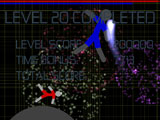
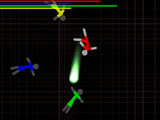
(Super Stealball Game Screenshots)
It’s a Steal
The full version of Super Stealball is priced at $9.95. At the time of this writing, though, the whole Rag Doll Software lineup is available half-price. Super Stealball is a great game to get in and out of quickly, and at $4.95 how can anyone resist?
Head on over to the Super Stealball page at Rag Doll Software to download the free demo (2.89 MB) or order the full version of this great physics game.
Related Posts:
- List of MacOS Physics Games
- List of Physics Games
- iPhone Physics Games Launch in July
- Excellent Marble Madness-Inspired Physics Game
- One-Part Tetris, One-Part Physics: Triptych
Merry-Goo-Round: Tower of Goo
Tower of Goo by Kyle Gabler is a product of the inaugural Experimental Gameplay Project. Kyle was a member of the first group of Carnegie Mellon University students. Since then, the project has grown–expanding in scope past the Entertainment Technology Center–but Tower of Goo is still a seminal example of the program’s success [pun intended].
Structural Integrity…Failing!
Tower of Goo is best described as Bridge Builder in real-time. The little blobs of goo crawling around your tower can be picked up and dropped as supports. Clicking on a piece of goo and dragging it around will highlight available locations: either as one span between two existing points, or two spans for a new point connecting two existing points. It makes a lot more sense when you see it in action–check the video.
Like many of the Experimental Gameplay Project games, there is no explicit goal in Tower of Goo. Implicitly, however, the goal is to build up. The game’s sole bit of statistical feedback is how tall your tower is. When you reach new heights, a happy bit of text appears as reward.
Blue Team, Goo!
What’s great about Tower of Goo is that the little blob guys, your resources, aren’t static. They actively climb around the tower trying to reach the highest point. Their weight will actually affect the tower, too, so if they all climb to one side of the tower you may need to quickly counteract by adding some weight to the other side. If your tower starts to significantly fall, you’re usually screwed; maybe some quick repair on the weak side will fix it. Maybe. Usually not, and everything comes crashing to the ground. No worries, though–you simply keep building from where things lay. There’s no timer and no game-imposed punishments.
Multiple Play Styles
The real-time nature of Tower of Goo supports multiple play styles. One player can choose to build slowly and carefully, making sure everything is stable before expanding. Or, and this is how I usually play, one can play very quickly. Careful placement isn’t as important as growing your structure as fast as possible. Of course, this typically results in a catastrophic failure of the tower at some point. But hey–that’s most of the fun.

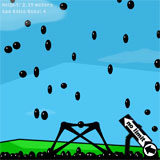
(Tower of Goo Game Screenshots)
It’s Goo Time
The original Tower of Goo took four days of Kyle’s time to develop. Since then, he’s released Tower of Goo Unlimited which enables unlimited vertical/horizontal expansion. It’s remarkably fun to play with, although without the meta structure of game goals on top of the mechanic it will get a little old. Still, it’s a small download and it’s totally free. Why aren’t you playing it already?
Download Tower of Goo Unlimited here (2.32 MB), or head over to the Experimental Gameplay Project website for more information.
Related Posts:
- A Classic: Bridge Builder by Chronic Logic
- The Beginning
- Builder Physics Games Evolved: Armadillo Run
- When You’re Mining for Gold, and You Forget…
- List of Physics Games
I Know Rag Fu: Ragdoll Matrix Reloaded
Ragdoll Matrix Reloaded is the sequel to Ragdoll Matrix, both by R-Tsa Games. The premise of both games is the same: You control a ragdoll character, trying to dodge bullets and bombs. In Ragdoll Matrix Reloaded, they applied the obvious theme of the Agent Smith character from the Matrix movies. It fits well.
Controls
The controls in Ragdoll Matrix are keyboard-driven. The arrow keys move you around, lead by your head. You have the ability to defy gravity, too, although only in limited amounts. The green meter represents how much anti-gravity juice you have left. It recharges pretty quickly, almost to the point where you could constantly hover.
The ragdoll character feels very sluggish. I suppose this adds to the difficulty of the game, but at times I’d wish things could be a little snappier. Compare the movements the agent character in Ragdoll Matrix Reloaded to the more fluid and responsive movements of the figures in Ragdoll Masters (which was inspired by the first Ragdoll Matrix game, by the way). Tuning a physics system to feel responsive is certainly no easy task, but I get the sense that the folks at R-Tsa didn’t do much at all in this department. It shows.
There are a set of advanced controls in Ragdoll Matrix Reloaded: the ability to go stiff, control your entire body, and stick your legs and arms to the ceiling. Unfortunately, you need to unlock these by abilities by playing through the game on various difficulty modes and settings. The little I was able to unlock was hard to control and not very intuitive.
Difficulty Progression
The goal of the game is to dodge bullets. At regular interviews, a handful of bullets come firing in from random positions on the screen. They always aim at you, so a good rule of thumb is to keep moving around the screen. The game has a very nice cinematic feel when events line up properly; bending over backwards to just barely dodge a bullet is a lot of fun.
On the harder levels, the bullets move faster, do more damage, and the game introduces bombs. Bombs bounce around and then explode, which in practice simply transform a section of the screen into a no-go zone.
Play Modes
Ragdoll Matrix Reloaded has a very neat asymmetrical same-computer two-player game mode. One player controls the Agent Smith character, as usual, but the other player moves the mouse cursor and gets to control the shots. They’re given a number of shots to fire at once, and get to click anywhere on screen to fire there. It’s much more interesting compared to the single-player mode, where the shots are always aimed directly at you.
There’s a proper networked multiplayer mode, too, although I wasn’t able to try it out.
Technology
Ragdoll Matrix Reloaded was created with Game Maker. Physics are handled by ODE via the GM_ODE bindings. It’s great to see physics games being produced by the game-development-for-everyone style middleware and packages.
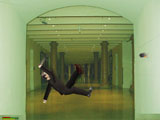
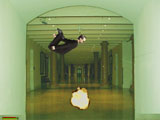
(Ragdoll Matrix Reloaded Game Screenshots)
Dodge This!
While Ragdoll Matrix Reloaded probably won’t hook you to the point of playing every day for hours at a time, it’s certainly a fun distraction. As physics games go it’s worth checking out. And, it’s freeware. You don’t have a reason not to play!
Download Ragdoll Matrix Reloaded game here (17.7 MB), the music-less version here (3.0 MB), or head on over to the R-Tsa Games homepage for more information.
Related Posts:
- List of Physics Games
- Nimble Ninjas Face Ferocious Foes
- Interview: Matteo Guarnieri, Rag Doll Software
- Walaber Experiments with Ragdolls and Aerial Skiing
- Physics-Based Beatdowns, Ragdoll Masters



 (Rate this game! 120 votes, average: 3.84 out of 5)
(Rate this game! 120 votes, average: 3.84 out of 5) My name is Matthew Wegner, and this site is dedicated to physics games.
My name is Matthew Wegner, and this site is dedicated to physics games.